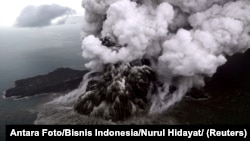Radar data from satellites, converted into images, shows Indonesia’s Anak Krakatoa island volcano is dramatically smaller following a weekend eruption that triggered a deadly tsunami.
Satellite photos aren’t available because of cloud cover, but radar images from a Japan Aerospace Exploration Agency satellite taken before and after the eruption show the volcano’s southwestern flank has disappeared.
Dave Petley, head of research and innovation at Sheffield University who analyzed similar images from a European Space Agency satellite, said they support the theory that a landslide, most of it undersea, caused the tsunami that killed at least 430 people Saturday evening.
“The challenge now is to interpret what might be happening on the volcano, and what might happen next,” he wrote in a blog.
JASA’s post-eruption image shows concentric waves radiating from the island, which experts say is caused by ongoing eruptions.
Alert raised
Meanwhile the continuing eruptions prompted Indonesia to raise the alert level Thursday to the second highest and ordered all flights to steer clear. The national geological agency, in raising the alert level, set a 5-km exclusion zone around the island.
Authorities have warned that the crater of Anak Krakatoa remains fragile, raising fears of another collapse and tsunami,
There are also fears of a bigger eruption.
The volcano has been rumbling on and off since July but has been particularly active since Sunday, spewing lava and rocks, and sending huge clouds of ash up to 3,000 meters into heavily overcast skies.
Child of Krakatoa
Anak Krakatoa, which means child of Krakatoa, is the offspring of the infamous Krakatoa volcano that affected global climate with a massive eruption in 1883.
Anak Krakatoa first rose above sea level in 1929, according to Indonesia’s volcanology agency, and has been increasing its land mass since then.
Reuters news agency contributed to this report.










